Review: Atom Fast Pocket Dosimeter
Hi geektimes. As a person who is fond of all kinds of gadgets, I certainly have a dosimeter at home. Not for reasons of radiophobia, but solely as an interesting physical device with which to measure something. It has long been thought to try new dosimeters - scintillation, but the main thing that stopped is the price. Finally, on New Year's Day, the time, availability of money and free time successfully coincided, and as a result, Santa Claus, in the person of the post office employee, brought me a small souvenir and dosimeter Atom Fast.

How it works, details under the cut.
')
Conventional dosimeters, known in the home as Geiger counters , have the same counter inside - a tube with rarefied gas. The gas breaks through when the particle passes, the electronic circuit captures a single pulse. How it looks, you can see in the review of the dosimeter SOEKS , where you can clearly see 2 installed on the board Geiger counter:
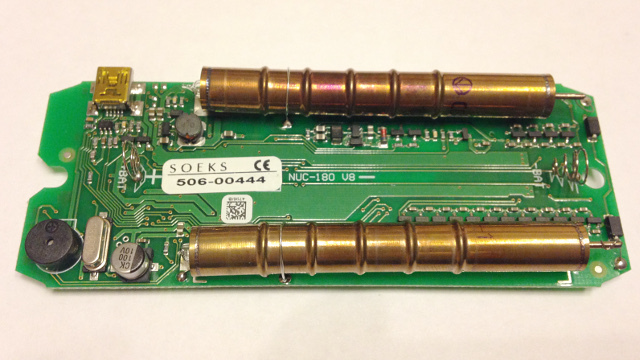
By counting the number of pulses per minute, you can calculate the background radiation.
Everything is good, but such meters have a problem: not very high efficiency. They register not too many pulses, so the counting time is quite large (about a minute). That is why, by the way, in the photo above you can see 2 detectors, and in some dosimeters they put 4 as well.
And now we come to the point - scintillation detectors. Unlike a Geiger counter, a scintillator is a crystal that can glow when a particle is in flight (for more information, see Wikipedia ). By combining such a crystal with a sensitive photo detector, you can get the same dosimeter, only much more compact and sensitive. According to the manufacturer, the sensitivity of the scintillation detector exceeds the sensitivity of the Geiger counter by 20 times. This means that if a conventional dosimeter takes about a minute to calculate the background, the scintillation detector will record it in just 3 seconds. The difference is really enormous, which allows the use of such detectors for searching, such as the classic Lidlum in the photo:
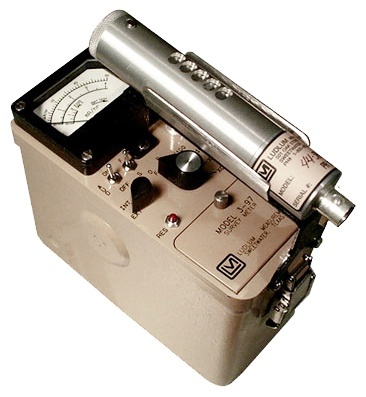
Such dosimeters used photomultipliers to amplify the signal from the crystal, which determined the price and size. Modern technologies allow to reduce the size so that the scintillation dosimeter can be placed even in the case of a wristwatch. Alas, this is still too expensive (the issue price is about $ 1000), so the hero of our review is a little bigger, although it is still very compact - a pocket bluetooth dosimeter Atom Fast.
The Atom Fast dosimeter is very similar in shape to a flashlight - but without any buttons or screens. Data is transmitted via Bluetooth LE, judging by the instructions, the operating time in this mode is about 2 months, which is more than enough. However, in addition to Bluetooth, there is a built-in “beeper” in the dosimeter, which allows it to be used independently (the response thresholds are set via a smartphone). You can turn off the wireless connection and simply carry the dosimeter in your pocket as an alarm device, the operating time will be up to 4 months.
The heart of the dosimeter is a scintillation crystal:
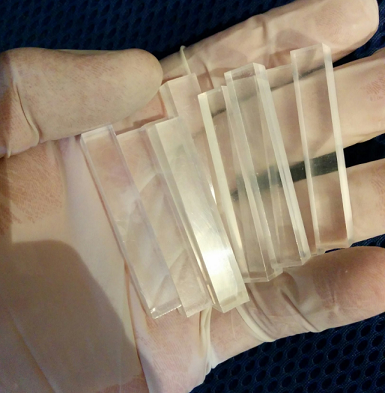
It is sealed in an opaque foil and connected to a solid-state photomultiplier, in the body it is placed like this:

(photos courtesy of the device developers)
The dosimeter itself, when used with a Sony Z3 Compact smartphone:

The main window of the program is the measurement mode. The dosimeter considers it really fast - it was enough to attach it to the kitchen sink, the screen immediately shows a slight excess of the background.
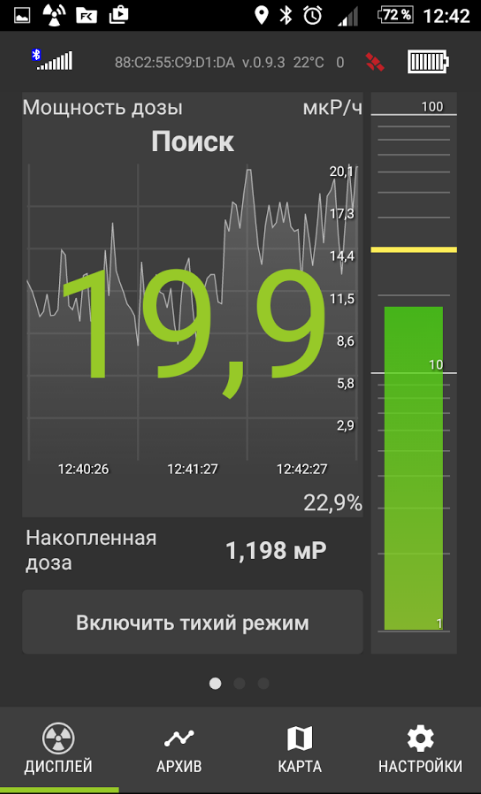
The second useful feature is the preservation in the archive of all measurements. Here, for example, the schedule for the day - the dosimeter just lay in your pocket.

It is clearly seen that in the office (time from 9 to 17) the average level of radiation is noticeably lower than at home in an apartment. The reason is probably in various building materials, but the excess is insignificant.
Finally, a very interesting mode is a map with superimposed indications. The fast measurement time of the dosimeter together with the presence of gps in the smartphone allows you to display data in the form of a map, which can be very interesting.
On the map below, you can clearly see a slight local excess of the background, where the street intersects with the highway.

Probably, the sanding road has a slightly elevated background, and part of it wakes up from the road. Moreover, the dosimeter just lay in your pocket, no special “events” were conducted for the search, the measurement speed is enough even for recording background changes just while walking. A conventional dosimeter with a Geiger counter would simply not have noticed such a slight excess.
Of course, no one will constantly look at the smartphone screen. To warn about the background increase, the dosimeter has a built-in piezo-dynamics and a vibration motor. Thresholds can be set through the software, and the sound and vibration signals in the smartphone itself can also be triggered.
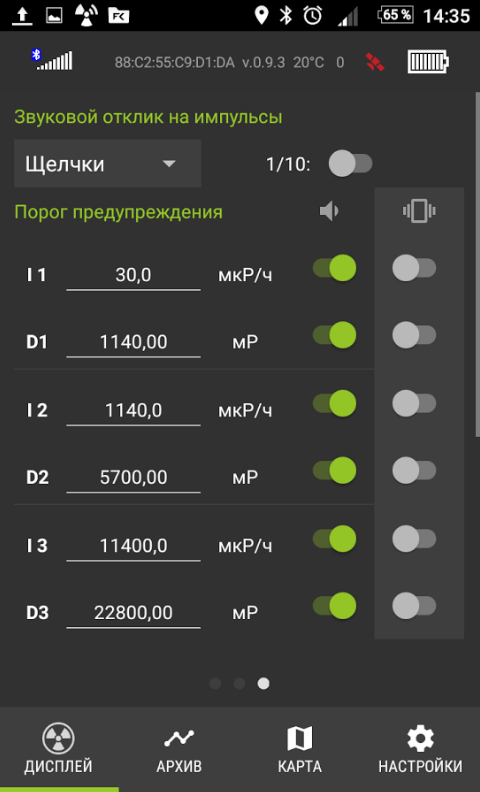
It is worth repeating that in the Atom Fast alarm mode it works autonomously, it is not necessary to have a smartphone with you.
The device can certainly be attributed to the top class of dosimeters, both in function and alas, in price. At the time of this writing, the cost of the Atom Fast from the version with the most sensitive crystal is 16500r. The version with a smaller crystal will cost 12500 rubles.
Advantages of the device:
- compactness
- long battery life
- inconspicuous appearance and communication range via Bluetooth up to 5-6 meters
- background record of all readings with the possibility of further analysis
Now about the minuses. Talking about the price is meaningless, it is clear that good equipment is not cheap. The main disadvantage is rather the absence of at least some small screen. Constantly getting the smartphone is not very convenient, and a small LCD indicator, like in hours, would not greatly increase the cost, but at times would increase the usability of the device. Perhaps, if a little bit to modify the device in terms of usability - add a screen, an on-off button (still the dosimeter is not needed every day) and change the non-standard charging connector to a regular micro usb - it would be a sales hit in its price category, well and so, the device receives a firm and well-deserved rating of "4+".
PS: Instead of completion, the answer to the question "why is this necessary." Fortunately, the dosimeter is not needed by an ordinary person every day. At the same time, the device can definitely be interesting for those who travel a lot, who live in places with possible contamination (as a relatively recent case, we can recall the city of Electrostal), who are faced with old electronic equipment (scales with SPD are not rare). The device can be useful for quick analysis of building materials, rare commission things, and so on. And finally, those who are simply interested in something new and unusual - the sensitive radiation sensor allows you to look at the world from a different angle. Almost everywhere - at home, on the street, in the subway, the levels of radiation are quite different, and it is very interesting to find a physical explanation for this.

How it works, details under the cut.
')
Theory
Conventional dosimeters, known in the home as Geiger counters , have the same counter inside - a tube with rarefied gas. The gas breaks through when the particle passes, the electronic circuit captures a single pulse. How it looks, you can see in the review of the dosimeter SOEKS , where you can clearly see 2 installed on the board Geiger counter:
By counting the number of pulses per minute, you can calculate the background radiation.
Everything is good, but such meters have a problem: not very high efficiency. They register not too many pulses, so the counting time is quite large (about a minute). That is why, by the way, in the photo above you can see 2 detectors, and in some dosimeters they put 4 as well.
And now we come to the point - scintillation detectors. Unlike a Geiger counter, a scintillator is a crystal that can glow when a particle is in flight (for more information, see Wikipedia ). By combining such a crystal with a sensitive photo detector, you can get the same dosimeter, only much more compact and sensitive. According to the manufacturer, the sensitivity of the scintillation detector exceeds the sensitivity of the Geiger counter by 20 times. This means that if a conventional dosimeter takes about a minute to calculate the background, the scintillation detector will record it in just 3 seconds. The difference is really enormous, which allows the use of such detectors for searching, such as the classic Lidlum in the photo:

Such dosimeters used photomultipliers to amplify the signal from the crystal, which determined the price and size. Modern technologies allow to reduce the size so that the scintillation dosimeter can be placed even in the case of a wristwatch. Alas, this is still too expensive (the issue price is about $ 1000), so the hero of our review is a little bigger, although it is still very compact - a pocket bluetooth dosimeter Atom Fast.
Practice
Hard
The Atom Fast dosimeter is very similar in shape to a flashlight - but without any buttons or screens. Data is transmitted via Bluetooth LE, judging by the instructions, the operating time in this mode is about 2 months, which is more than enough. However, in addition to Bluetooth, there is a built-in “beeper” in the dosimeter, which allows it to be used independently (the response thresholds are set via a smartphone). You can turn off the wireless connection and simply carry the dosimeter in your pocket as an alarm device, the operating time will be up to 4 months.
The heart of the dosimeter is a scintillation crystal:

It is sealed in an opaque foil and connected to a solid-state photomultiplier, in the body it is placed like this:

(photos courtesy of the device developers)
The dosimeter itself, when used with a Sony Z3 Compact smartphone:

Soft
The main window of the program is the measurement mode. The dosimeter considers it really fast - it was enough to attach it to the kitchen sink, the screen immediately shows a slight excess of the background.

The second useful feature is the preservation in the archive of all measurements. Here, for example, the schedule for the day - the dosimeter just lay in your pocket.

It is clearly seen that in the office (time from 9 to 17) the average level of radiation is noticeably lower than at home in an apartment. The reason is probably in various building materials, but the excess is insignificant.
Finally, a very interesting mode is a map with superimposed indications. The fast measurement time of the dosimeter together with the presence of gps in the smartphone allows you to display data in the form of a map, which can be very interesting.
On the map below, you can clearly see a slight local excess of the background, where the street intersects with the highway.

Probably, the sanding road has a slightly elevated background, and part of it wakes up from the road. Moreover, the dosimeter just lay in your pocket, no special “events” were conducted for the search, the measurement speed is enough even for recording background changes just while walking. A conventional dosimeter with a Geiger counter would simply not have noticed such a slight excess.
Warning mode
Of course, no one will constantly look at the smartphone screen. To warn about the background increase, the dosimeter has a built-in piezo-dynamics and a vibration motor. Thresholds can be set through the software, and the sound and vibration signals in the smartphone itself can also be triggered.

It is worth repeating that in the Atom Fast alarm mode it works autonomously, it is not necessary to have a smartphone with you.
findings
The device can certainly be attributed to the top class of dosimeters, both in function and alas, in price. At the time of this writing, the cost of the Atom Fast from the version with the most sensitive crystal is 16500r. The version with a smaller crystal will cost 12500 rubles.
Advantages of the device:
- compactness
- long battery life
- inconspicuous appearance and communication range via Bluetooth up to 5-6 meters
- background record of all readings with the possibility of further analysis
Now about the minuses. Talking about the price is meaningless, it is clear that good equipment is not cheap. The main disadvantage is rather the absence of at least some small screen. Constantly getting the smartphone is not very convenient, and a small LCD indicator, like in hours, would not greatly increase the cost, but at times would increase the usability of the device. Perhaps, if a little bit to modify the device in terms of usability - add a screen, an on-off button (still the dosimeter is not needed every day) and change the non-standard charging connector to a regular micro usb - it would be a sales hit in its price category, well and so, the device receives a firm and well-deserved rating of "4+".
PS: Instead of completion, the answer to the question "why is this necessary." Fortunately, the dosimeter is not needed by an ordinary person every day. At the same time, the device can definitely be interesting for those who travel a lot, who live in places with possible contamination (as a relatively recent case, we can recall the city of Electrostal), who are faced with old electronic equipment (scales with SPD are not rare). The device can be useful for quick analysis of building materials, rare commission things, and so on. And finally, those who are simply interested in something new and unusual - the sensitive radiation sensor allows you to look at the world from a different angle. Almost everywhere - at home, on the street, in the subway, the levels of radiation are quite different, and it is very interesting to find a physical explanation for this.
Source: https://habr.com/ru/post/400949/
All Articles